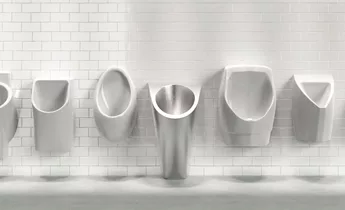Blogs
8 Ways that Waterless Urinals are better than Traditional Urinals

Waterless urinals offer an innovative and environmentally friendly alternative to traditional flush urinals. Unlike conventional systems that rely on water to flush away waste, waterless urinals – as the name suggests – are completely water-free.
Utilizing a cartridge and seal system, the technology offers numerous advantages over traditional flush systems, including cost savings, improved hygiene, environmental sustainability and much more.
In this article, we take a look at the ways in which waterless urinals are superior to traditional flush systems.
Zero water use
Traditional urinals rely on a flow of water to rinse away urine and maintain cleanliness. This leads to significant water consumption – as much as 42% of total water use in busy commercial spaces – which is flushed down the drain.
Waterless systems use zero water. A one way, non-return hygiene valve prevents odours from beneath the bowl, and a bio-cartridge (containing biological enzymes) prevents odours above the bowl, eliminating the need for water altogether. This innovative design drastically cuts utility bills, as well as the maintenance requirements and operational costs associated with water usage.
Reduced energy use
With no flushing system to operate, waterless urinals save energy as well as water. And because they use no water, which often comes from potable or desalinated sources, both of which are costly and use vast amounts of energy to produce, they contribute to reduced energy use and CO2 emissions.
Improved hygiene
With a continuous flow in traditional urinals, water can stagnate and create moist environments in which bacteria grow and unpleasant odours form. This compromises hygiene standards, leading to an overall unappealing restroom environment for users.
Thanks to their innovative design and lack of water, waterless urinals offer a more hygienic solution. The seal and cartridge technology is designed to allow urine to flow away into the main stack, eliminating the need for a flush, and preventing stagnated water and odour formation. This ensures a dry and inhospitable environment for bacteria, resulting in cleaner and more hygienic restroom facilities.
Lower bacterial levels also reduce the risk of cross-contamination and the spread of germs, promoting public health and wellbeing in shared restroom facilities, enhancing user comfort and satisfaction. And with flushing removed, no micro droplets of water are released into the air, which can be ‘vehicles’ to transport bacteria away from the bowl.
Environmentally friendly
With such significant water and energy savings, waterless urinals are an all-round more environmentally friendly option, which are helping businesses achieve their sustainability goals.
With the introduction of stringent environmental targets and ESG standards, commercial businesses need to find simple, cost-effective solutions that will make a big impact on their environmental footprint. With urinals being accountable for such a significant proportion of total water use for many businesses, a waterless system is an obvious place to start when looking to slash water use.
And because the units use no water, they reduce the buildup of bacteria and unpleasant odours, mitigating the need for more aggressive cleaning and the use of harsher, environmentally damaging cleaning products.
Easier installation
With no expensive flush or complicated water in lines, waterless urinals are simple to install. They can be retrofitted to 95% of all existing urinal bowls and added to new builds with minimal cost. This removes the need to plumb the systems in and leads to an estimated 30% saving on new project costs.
Easier maintenance
With no moving parts or water supply lines, waterless urinals are easier to maintain than traditional flush urinals. Maintenance simply involves periodically replacing the hygiene valve and cartridge, which is a straightforward process.
Fewer repairs
With traditional flush mechanisms, moving parts and water supply lines require frequent cleaning, increasing the risk of plumbing issues such as clogs or leaks. Valves and batteries also need to be replaced, pushing up maintenance costs.
With no such mechanism in a waterless urinal, plumbing issues are eliminated, and the likelihood of costly repairs or replacements over time are reduced.
Significant cost saving
Waterless urinals offer substantial cost savings compared to traditional flush urinals. By eliminating the need for water and reducing maintenance requirements, they significantly lower utility bills and operational expenses for FM teams. And thanks to the long-term durability and reliability of waterless urinal systems, repairs and replacements are minimized and further longer-term cost savings achieved.
Waterless urinals offer significant benefits, making them a superior choice over traditional urinals. Eliminating the need for water consumption, they reduce pressure on our precious resources and minimize the environmental impact of excessive water usage.
By embracing waterless urinal technology, FM teams can promote water conservation, enhance restroom cleanliness, and reduce operational costs, ultimately creating a more sustainable and user-friendly restroom environment for all.
Latest Posts
How a Sustainable Solar Panel Solution is Addressing the Environmental Burden of Solar Maintenance
While solar panels offer one of the greenest, most sustainable sources of energy, their upkeep and solar panel cleaning maintenance can be far from environmentally friendly.
Boosting Climate Resilience with Intelligent Washrooms and Facility Management Tech
As climate change continues, buildings and facility management (FM) teams are under increasing pressure to operate more sustainably.
How Smart Water Metering Systems Are Transforming Water Management in Residential Towers
Densely populated cities in the Middle East are placing a huge amount of pressure on already scarce water resources.
Smart Washroom Technology and its role in Corporate Environmental Responsibility (CER)
Sustainability is no longer a peripheral concern; it is an operational imperative for businesses.
Unlocking the Full ROI of Smart Washroom Technology
Smart washroom technology delivers far-reaching benefits that go beyond traditional expectations.
